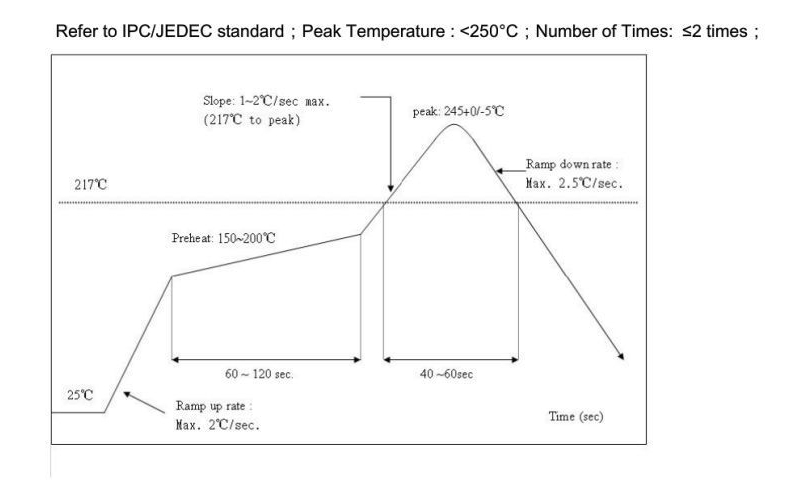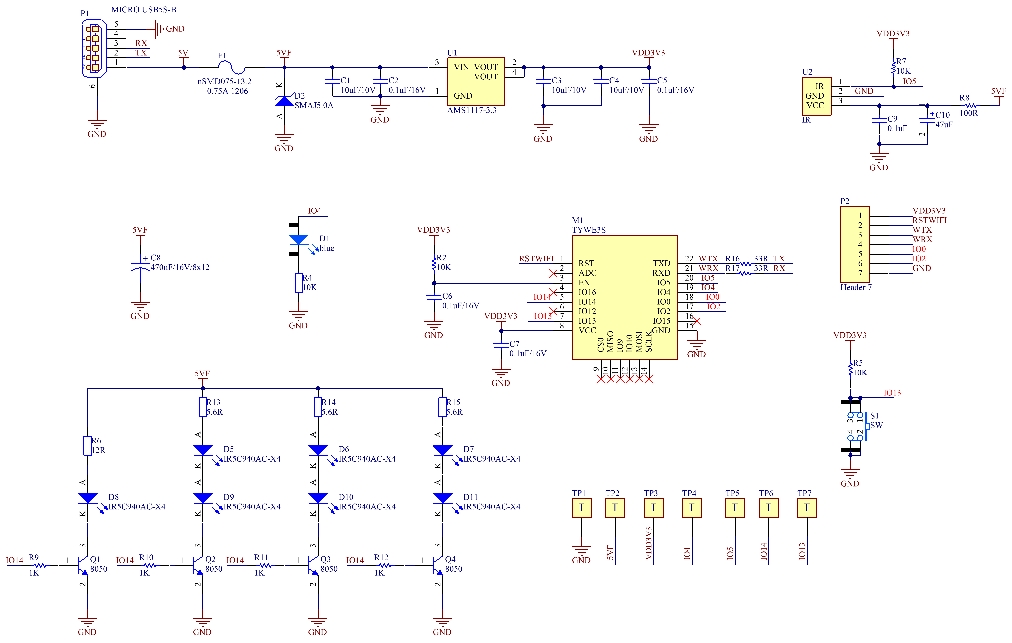Remote Control
TYSW-012 Round Universal Remote Control
Product Overview
TYSW_012 is an infrared (IR) universal remote control that Hangzhou Tuya Inc. has developed. It consists of a low-power TYWE3S Wi-Fi module, an IR emitter, and an integrated IR receiver. Figure 1 shows the TYSW_012 architecture.

Figure 1 TYSW_012 architecture
The TYWE3S module consists of a highly integrated RF chip (ESP8266) and several peripheral components, with a built-in Wi-Fi network protocol stack and robust library functions. It is embedded with a low-power 32-bit CPU, 1 MB flash memory, and 50 KB SRAM, and has extensive peripherals. TYWE3S is an RTOS platform that integrates all the function libraries of the Wi-Fi MAC and TCP/IP protocols. Figure 2 shows the TYWE3S architecture.

Figure 2 TYWE3S architecture
Features
Power input: 5 V DC 1 A (over a micro USB port)
Standby power: ≤ 0.4 W
Working temperature: -10°C to +50°C
Working humidity: ≤ 85% RH
Connection mode: 2.4 GHz 802.11b/g/n
IR learning frequency: 38 kHz
IR direction: multidirectional
IR control distance: ≤ 8 m (horizontal control) or ≤ 15 m (pointing to the controlled device), which may vary depending on the environment
IR learning distance: ≤ 3 m (pointing to the controlled device) and a ±45° angle, which may vary depending on the environment
Supported devices: devices that run Android 4.0 or iOS 8.0 and later versions
Applications
All IR home appliances that use the 38 kHz carrier frequency
Electrical Parameters
Absolute Electrical Parameters
Table 1 Absolute Electrical Parameters
Parameter
Description
Minimum Value
Maximum Value
Unit
Ts
Storage temperature
–20
85
°C
VCC
Power supply voltage
–0.3
5.5
V
Static electricity voltage (human body model)
Tamb –25°C
N/A
2
kV
Static electricity voltage (machine model)
Tamb –25°C
N/A
0.5
kV
Power Consumption in Different Working Modes
Table 2 TYSW_012 working current
Working Mode
Working Status (Ta = 25°C)
Average Value
Maximum Value
Unit
EZ
The module is in EZ mode, and the Wi-Fi indicator blinks quickly.
80
151
mA
AP
The module is in AP mode, and the Wi-Fi indicator blinks slowly.
90
451
mA
Connected
The module is connected to the network, and IR transmission is enabled.
70
500
mA
Disconnected
The module is disconnected from the network, and the Wi-Fi indicator is steady off.
80
430
mA
RF Features
Basic RF Features
Table 3 Basic RF features
Parameter
Description
Frequency band
2.412 GHz to 2.484 GHz
Wi-Fi standard
IEEE 802.11b/g/n (channels 1 to 14)
Data transmission rate
802.11b: 1, 2, 5.5, or 11 (Mbit/s); 802.11g: 6, 9, 12, 18, 24, 36, 48, or 54 (Mbit/s) ; 802.11n: HT20 MCS0 to MCS7
Antenna type
PCB antenna
Wi-Fi Output Power
Table 4 Power during constant transmission
Parameter
Minimum Value
Typical Value
Maximum Value
Unit
Average RF output power, 802.11b CCK mode
1 Mbit/s
N/A
20
N/A
dBm
Average RF output power, 802.11g OFDM mode
54 Mbit/s
N/A
17
N/A
dBm
Average RF output power, 802.11n OFDM mode
MCS7
N/A
14
N/A
dBm
Frequency error
–10
N/A
+10
ppm
Wi-Fi RX Sensitivity
Table 5 RX sensitivity
Parameter
Minimum Value
Typical Value
Maximum Value
Unit
PER < 8%, 802.11b CCK mode
1 Mbit/s
N/A
–91
N/A
dBm
PER < 10%, 802.11g OFDM mode
54 Mbit/s
N/A
–75
N/A
dBm
PER < 10%, 802.11n OFDM mode
MCS7
N/A
–72
N/A
dBm
Mechanical Dimensions and Production Instructions
Mechanical Dimensions

Figure 3 TYSW_012 mechanical dimensions
Production Instructions
Storage conditions for a delivered product are as follows:
The moisture-proof bag is placed in an environment where the temperature is below 30°C and the relative humidity is lower than 85%.
The shelf life of a dry-packaged product is six months from the date when the product is packaged and sealed.
Precautions:
Throughout the production process, each involved operator must wear an ESD wrist strap.
During the operation, strictly protect the product from water and stains.
Recommended Oven Temperature Curve

Appendix: Schematic Diagram

Change History
No.
Date
Change Description
Version After Change
1
2018-08-17
This is the first release.
1.0.0
Last updated
Was this helpful?